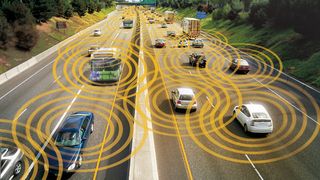How vehicle-to-vehicle communication could save (and endanger) lives
Analysis: Cars will soon talk to each other, but what does that mean?

Car technology is getting a lot of buzz of late, with the likes of Google and Apple both making their way into car technology, along with a host of other tech firms.
Most recently found in the press is self-driving technology, along with things like advanced infotainment systems. However there's one piece to the puzzle that hasn't gotten much love: vehicle-to-vehicle communication, or V2V.
Vehicle-to-vehicle communication can take a number of forms, at its most basic being a way for cars within a certain range to let each other know of any dangers, and at its most advanced being a massive network that operates like the Internet of Things for cars. In any case, cars are connected through sensors and communication technologies similar to Wi-Fi. All this is dedicated to one cause: saving lives.
V2V communication is not the same as self-driving cars
Imagine you're driving down the road, minding your own business, when you come to a stop light. Naturally, you slow down, but as you do, the light turns green. As you begin to accelerate again, warning signals begin flashing and your seat begins vibrating. Your car is telling you to stop.
As you slam on the brakes, a car whizzes in front of you, having run a red light that might recently have been yellow. How did you know to stop? Your car told you, and if it hadn't, there might have been a serious accident. How did your car know to stop? Well, the car that ran the red light told it.
When we think of connected cars, it's common to think of something that exists in the distant future, where cars are driving themselves and as such need to know what's happening on the road. However, connected cars have applications beyond self-driving.
People, unfortunately, break the rules of the road all the time, and sometimes there's just no way to anticipate a potentially fatal incident. But the technology that can warn drivers of an impending accident could help put an end to accidents caused by reckless drivers. Not only that, but this technology will appear in our cars – self-driving or otherwise – within the next few years.
Get daily insight, inspiration and deals in your inbox
Get the hottest deals available in your inbox plus news, reviews, opinion, analysis and more from the TechRadar team.

In fact, many expect V2V communication to have an even bigger impact on safety than autonomous vehicle technology. But self-driving cars are still in need of development. They get confused easily in any weather that's not normal for an October day in California. They sometimes can't deal with sudden, unexpected obstacles, like other human drivers.
At the moment, humans are still better drivers than machines, but they need help.
This is only the beginning
None of this is to say that creating a massive network of cars that can talk to each other is easy. In fact, it will likely take many years before this kind of technology is widespread, mainly because of the fact that many people prefer to buy used cars, and these people won't be buying a car with this technology until at least a few years after its release.
Not only that, but vehicle-to-vehicle communication, despite its name, isn't limited to just vehicles communicating with other vehicles. Cars could also receive data from traffic lights, they'll know when the speed limit changes and they'll know what the weather looks like. This is known as vehicle-to-infrastructure, or V2I, communication.
V2V technology could help prevent as much as 80% of accidents that involve sober drivers that are driving their cars, according to the National Highway Traffic Safety Administration. That only leaves another 20% to be taken care of by self-driving technology.
While cars are becoming commonly connected to the Internet, it is more likely that – at least initially – cars will instead communicate through Wi-Fi-like technologies. Initial plans use a type of communication called dedicated short-range communications, or DSRC, which communicates to other cars over seldom-used frequencies, like 5.9GHz – unlike saturated signals, like 2.4GHz Wi-Fi. What this means is that cars will communicate with other cars within up to 300 meters, or 1,000 feet, which roughly translates to 10 seconds away on the highway.
Christian is a writer who's covered technology for many years, for sites including Tom's Guide, Android Central, iMore, CNN, Business Insider and BGR, as well as TechRadar.
Most Popular

